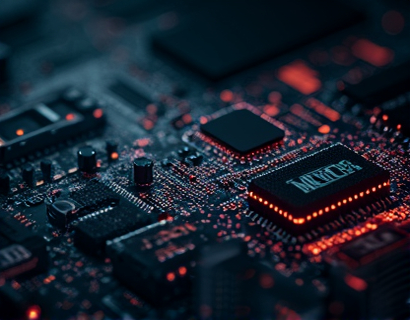Unlocking Scalability and Security: Cutting-Edge Layer 2 Solutions for EVM-Enabled Blockchain Development
In the rapidly evolving landscape of blockchain technology, especially for those leveraging the Ethereum Virtual Machine (EVM), scalability and security remain paramount challenges. As decentralized applications (dApps) continue to proliferate, the need for solutions that enhance performance without compromising on security becomes increasingly critical. This article delves into the transformative impact of advanced Layer 2 (L2) solutions on EVM-based blockchain development, focusing on how these innovations can unlock the next generation of dApps by improving scalability, security, and efficiency.
Understanding Layer 2 Solutions
Layer 2 solutions refer to technologies built on top of existing blockchain networks (Layer 1) to enhance transaction throughput and reduce costs. Unlike Layer 1 upgrades which involve modifying the core protocol, L2 solutions operate within the existing framework, providing a more agile and flexible approach to addressing scalability issues. For EVM-based blockchains, L2 solutions are particularly valuable as they maintain compatibility with smart contracts while introducing significant performance improvements.
Key Benefits of Layer 2 Solutions
The primary advantages of implementing Layer 2 solutions in EVM-based blockchain development are scalability, cost reduction, and enhanced security. By offloading a significant portion of the transaction processing to L2 layers, the main chain can focus on critical operations, leading to faster block times and lower transaction fees. This not only improves user experience but also makes blockchain technology more accessible to a broader audience.
Security is another critical aspect where L2 solutions excel. Through mechanisms like state channels, sidechains, and rollups, these solutions ensure that transactions are secure and verifiable on the main chain, thereby mitigating risks associated with off-chain processing. This dual-layer approach allows developers to leverage the strengths of both worlds, achieving high throughput without sacrificing the integrity of the blockchain.
Types of Layer 2 Solutions
Several types of Layer 2 solutions are particularly relevant for EVM-based blockchain development:
- State Channels: These allow multiple parties to conduct a series of transactions off the main chain, settling the final state on the blockchain. This method is highly efficient for applications requiring frequent, low-value transactions, such as gaming or micropayments.
- Sidechains: Independent blockchains that run parallel to the main chain, enabling different consensus mechanisms and faster transaction processing. Assets can be seamlessly transferred between the main chain and sidechains, providing flexibility and scalability.
- Rollups: Rollups bundle multiple transactions into a single transaction on the main chain, significantly reducing gas costs and increasing throughput. Optimistic and zk-Rollups are two prominent types, with zk-Rollups offering better scalability and faster confirmation times.
- Plasma: A tree-like structure where child chains (plasma chains) handle transactions, with only the final states submitted to the main chain. This approach can handle a large volume of transactions efficiently, though it requires careful design to ensure security and scalability.
Enhancing Scalability with Layer 2 Solutions
Scalability is often the bottleneck in blockchain systems, limiting the number of transactions that can be processed per second. Layer 2 solutions address this by distributing the load and optimizing transaction processing. For instance, state channels can handle thousands of transactions between two parties without impacting the main chain, making them ideal for applications like decentralized finance (DeFi) and non-fungible tokens (NFTs).
Rollups, especially zk-Rollups, offer remarkable scalability by processing thousands of transactions off-chain and submitting a single proof to the main chain. This not only reduces congestion but also lowers transaction fees, making blockchain technology more viable for widespread adoption. The efficiency gains from these solutions enable developers to build more complex and interactive dApps without worrying about performance issues.
Ensuring Security in Layer 2 Implementations
While Layer 2 solutions significantly enhance scalability, maintaining security is equally crucial. One of the key security features of L2 solutions is the use of cryptographic proofs, such as zk-SNARKs in zk-Rollups, which verify the validity of off-chain transactions without revealing sensitive information. These proofs ensure that only valid transactions are submitted to the main chain, preserving the integrity of the blockchain.
Another important aspect is the robustness of the interoperability mechanisms between the main chain and L2 layers. Secure and reliable bridges are essential to prevent vulnerabilities that could be exploited. Developers must carefully design and implement these bridges, ensuring they adhere to best security practices and undergo thorough auditing.
Case Studies and Real-World Applications
Several projects have successfully implemented Layer 2 solutions to enhance their EVM-based blockchain applications. For example, a popular DeFi platform leveraged state channels to reduce transaction costs and improve user experience, resulting in a significant increase in user engagement and transaction volume. Another project utilized zk-Rollups to launch a scalable NFT marketplace, achieving high throughput and low fees, which attracted a large user base.
These case studies demonstrate the practical benefits of Layer 2 solutions in real-world scenarios, showcasing their potential to transform various blockchain applications. By adopting these technologies, developers can create more efficient, secure, and user-friendly dApps.
Challenges and Considerations
While the benefits of Layer 2 solutions are clear, there are challenges and considerations that developers must address. One major challenge is the complexity of integrating L2 solutions with existing EVM-based infrastructure. Developers need to have a deep understanding of both the main chain and the L2 layer to ensure seamless integration and optimal performance.
Another consideration is the user experience. While L2 solutions can significantly improve backend performance, the front-end experience must remain intuitive and user-friendly. Developers should focus on creating interfaces that abstract the complexity of L2 technologies, allowing users to benefit from enhanced scalability and security without technical barriers.
Future Trends and Innovations
The landscape of Layer 2 solutions is rapidly evolving, with ongoing research and development pushing the boundaries of what is possible. One emerging trend is the integration of Layer 2 solutions with Layer 1 upgrades, creating a synergistic effect that further enhances blockchain performance. Additionally, the development of cross-chain interoperability protocols is enabling more seamless interactions between different blockchain ecosystems, expanding the potential applications of L2 solutions.
Another area of innovation is the use of machine learning and artificial intelligence to optimize L2 transaction processing and security mechanisms. These advanced technologies can help predict and mitigate potential bottlenecks and security threats, ensuring a more resilient and efficient blockchain environment.
Conclusion
Layer 2 solutions represent a transformative force in EVM-based blockchain development, offering unparalleled opportunities to enhance scalability, security, and efficiency. By leveraging these advanced technologies, developers can build next-generation dApps that are not only more performant but also more secure and cost-effective. As the blockchain ecosystem continues to mature, the adoption of Layer 2 solutions will play a crucial role in driving innovation and widespread adoption of decentralized technologies.










































